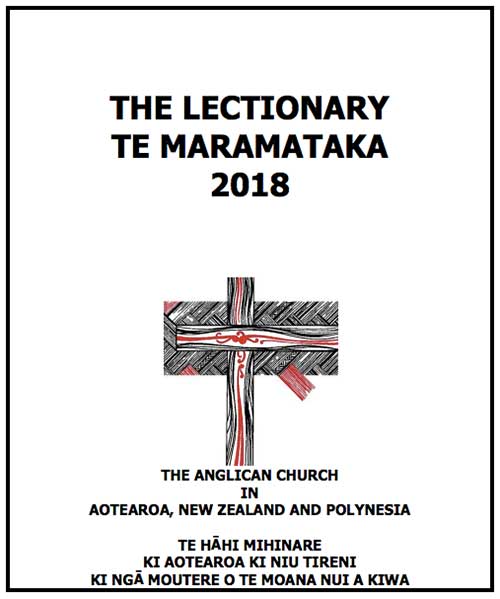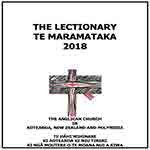
You will find New Zealand’s Lectionary Te Maramataka 2018 PDF online (1.58 MB – click link to download). Page numbers of the printed booklet are identical to the online version.
This post is just a collection of comments from a quick first glance. There is much in a publication such as this that is good and is of value, helping connect to the world-wide church, and back through the traditions of the centuries, while grounding us in this place in the South Pacific, at this time. Those tend to mostly be when the lectionary booklet expresses what we have agreed together – including celebrations of days that are international and ecumenical, as well as of persons who have expressed God’s love and life on these shores.
In a document like a lectionary, the devil, of course, is in the detail. That detail will, for some, appear as nitpicking (gnatpicking?). Pleasingly, some errors noted on this site last year have been corrected this year.
Page 5 now includes a link to the online version of A New Zealand Prayer Book He Karakia Mihinare o Aotearoa. A trick for new players there: if you are looking for the diglot material (English – Te Reo Maori) starting at page 476, that has been separated into two sections:
Te Whakawhetai me te Whakamoemiti
Thanksgiving and Praise
The trial collects have again been added in full in most places. This is an addition that will make this trial more widely known. Using any other collect continues to be allowed.
Some errors have not been corrected. General Synod Te Hinota Whanui (GSTHW) went to significant effort (starting four years ago and debated in every diocesan synod and hui amorangi, then debated again at the next meeting of General Synod Te Hinota Whanui) about the use of “of, in, or after” in titles for Sundays. The agreement was Sundays “of Epiphany” – yet the Lectionary calls them Sundays “of the Epiphany”. This error was pointed out two years running now.
Our church’s formulary (agreement) is that “Ordinary time is the period after the Feast of the Presentation of Christ” (February 2). Yet the first Sunday after The Presentation (February 4), rather than being called the “1st Sunday in Ordinary Time” (following our GSTHW ruling) is called the “5th Sunday in Ordinary Time”. There is no sign of the 4th, 3rd, or earlier Sunday in Ordinary Time.
The 5th Sunday in Lent (March 18) is optionally called “Passion Sunday” while there is no mention of the Passion. Ecumenical, international reform has the reading of the Passion on the 6th Sunday in Lent (as our Lectionary does also). The title “Passion Sunday” is, hence, best reserved for that international, ecumenical agreement.
“after” was not an option in GSTHW but “Sunday after Ascension” is an option in the Lectionary for 13 May. On page 40 begins readings for “the 3rd Week of Lent” (should that be “in Lent”?). Furthermore these readings are said to originate in “CWL” – there is no indication what CWL stands for or its status in our church or why there are not similar readings provided for the 1st and 2nd weeks “of Lent”.
‘Propers’ appear without any explanation. The first time is on page 14 where it talks about Propers I, II, and III (Roman numerals) followed immediately by Propers 1, 2, and 3 (Arabic numerals – page 15). Proper I (Roman numeral) is assigned to “Midnight”; Proper 1 (Arabic numeral) is given as being for “Christmas Day at Dawn”.
‘Proper 1’ reappears again on page 30 (again with no explanation). This (page 30ff) Proper numbering is what the Ordinary Sunday numbering would be if we followed our own agreement that Ordinary Time begins after the Presentation!
As in previous years, I would be interested to know where this lectionary booklet gets the ruling from: “The reading from Acts must be used each Sunday in Eastertide” (pages 52ff). It may very well be a good idea – but where does “must” come from? We are only required to follow formularies of our church – not what is indicated by this lectionary booklet. This is an important principle. Where the lectionary booklet does not conform to the formularies, we must follow the formularies, not the lectionary booklet. Where the lectionary booklet sets requirements beyond what the formularies require, we do not need to follow the booklet.
[Furthermore, as an aside, where does “Eastertide” come from in this lectionary booklet? Our formularies consistently call this “The Season of Easter”.]
I don’t know why there are the mostly-blank pages: 118, 119, 128, 129…
Forgetting Remembrance?
Each year, I have been noting our Anglican Church of Or suggestion to have all four colours in the lectionary for the Second Sunday in November (the colours in the lectionary booklet are not required to be followed – in fact, the lectionary booklet itself claims it is simply collating “common practice in most parishes” page 4). That is solved in 2018 by removing the celebration of Remembrance Sunday as an option. This is the first time that Remembrance Sunday has been dropped from the lectionary booklet in the decades that I have been paying attention to the lectionary.
All the other issues of the Anglican Church of Or continue
November 25 can be:
Christ the King Sunday
or The Reign of Christ Sunday
or 34th Sunday in Ordinary Time
or Sunday before Advent
or Aotearoa Sunday
or Feast of Christ in All Creation
or, of course, A Spring Festival of Praise to the Creator (see page 141).
Are there any things you notice as you skim through the lectionary booklet for 2018 – things you like; things you think can be improved?
If you appreciated this post, consider liking the liturgy facebook page, using the RSS feed, and/or signing up for a not-very-often email, …




The comment about requiring the reading from Acts on Sundays in Eastertide points to three further issues:
1. The Sunday readings are designed to make sure that we read (almost) all scripture throughout a three-year period and don’t just concentrate on the bits we like/can stomach/prefer to preach on/think people will put up with listening to/have time for/etc. To “require” the reading from Acts in Eastertide implies that other readings can be be dropped. My own experience in going to different churches on Sundays is that this is often the practice, especially as regards the psalm, and I wonder why? When I experience this it feels like an impoverishment. Usually the sermon could easily have been abbreviated by the length it would have taken for the ommitted reading(s); increasingly I find more nourishment in scripture than in preaching. This, of course, is the principle behind Cranmer’s aim to cover the whole of scripture each year in the Daily Office lectionary.
2. The lectionary is the set of readings read each Sunday in church. It is not a list of options to be chosen from the shelf. Without being legalistic about it this does safeguard the basic principles of 1 above.
3. The reading of scripture is a basic element of the Eucharist. There is a tendency to look on the readings as a sort of ancillary part of the Eucharistic action, yet they are a basic part of the process by which the dis-membered Body of Christ remembers and is re-membered.
Thanks so much for this wonderful comment, David! You speak of shortening the sermon without much loss (and remember, we say the Bible is inspired – many sermons are not even inspiring let alone inspired!) I am regularly irritated by the verbal clutter of our services – several greetings are followed by optional prayers, quotes, and reciting pious poetry at one another. The Gathering rite is to help us gather (as you indicate in your third point) to hear together what the Spirit is saying to us in the inspired Word. But by the time we get to the readings we are so exhausted by the verbally cluttered vestibule, we are only given a couple of short texts from the scriptures if we are lucky! [Some just read the Gospel – and even then, I’ve been present when there is one reading: “from the Holy Gospel according to the Galatians…”] That’s not even mentioning the leader’s introduction of their favourite bits and stage instructions (“now I’m just going to do this… now we are just going to do that…”) And then there’s the penchant for multiplying the number of leaders – with the concomitant issue that each one has to be given a pile of stuff to actually do and be seen to be “leading”. Blessings.
In TEC, Ordinary Time begins on the Sunday after the Epiphany (6 JAN) and the Sundays are numbered as Sundays after Epiphany up to the Sunday before Ash Wednesday. They then become numbered Sundays in Lent.
I think that many folks get confused about in and of. In the TEC prayerbook, Sundays considered part of a season are Sundays of the Season. Because Sundays during the Season of Lent are not days of Penitence, they are numbered Sundays in Lent.
Even I get confused if a think about it too much, so forgive any errors above!
Thanks, David. I think TEC has tended to try to produce a consistent approach within and around its BCP. NZ has tended to patch together really good ideas from different places – and sometimes the stitching shows badly: Ordinary Time Sunday numbering from Rome (from after January 6) doesn’t marry to CofE’s new idea of having Ordinary Time begin Feb 2 (CofE doesn’t number Ordinary Sundays) – and then including TEC’s Proper numbering as well (without explanation)… Blessings.